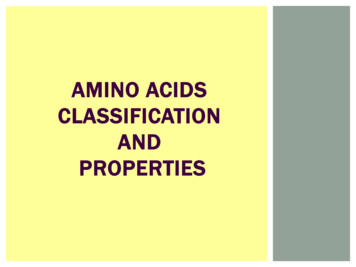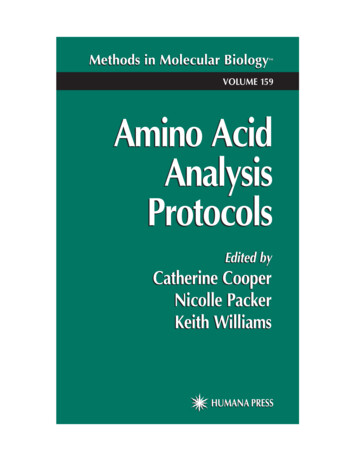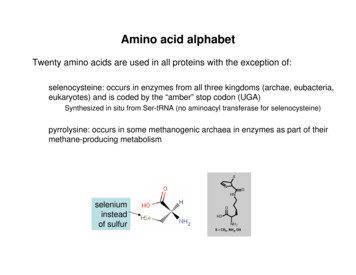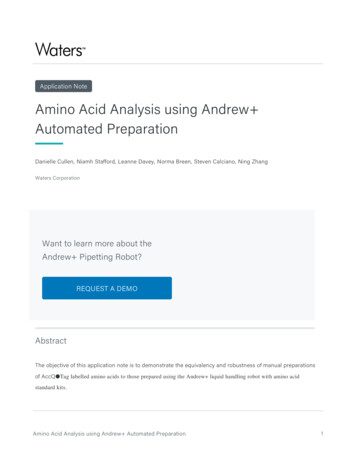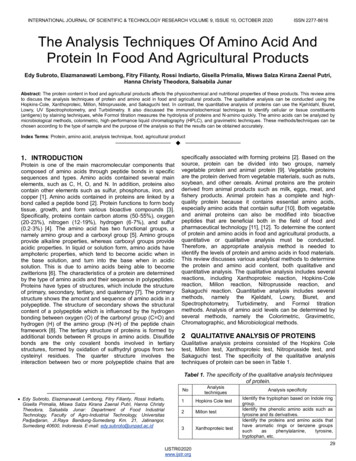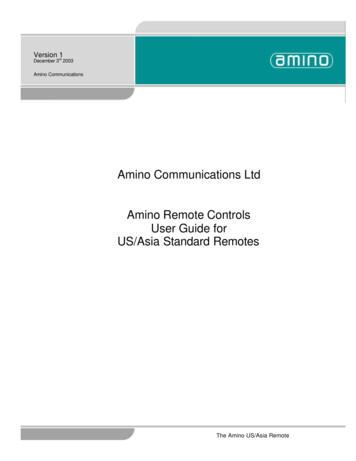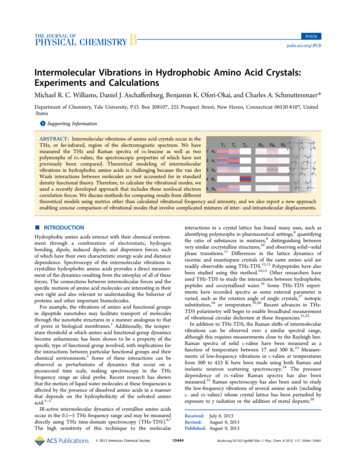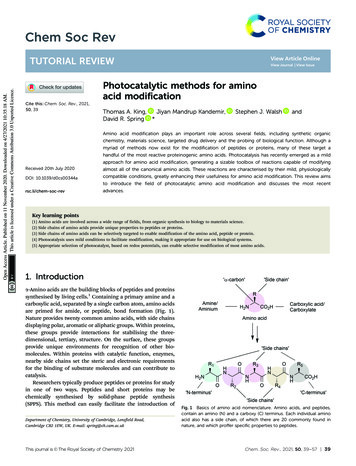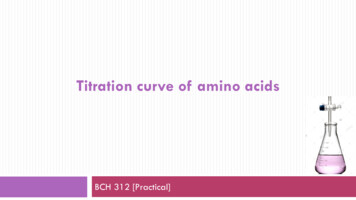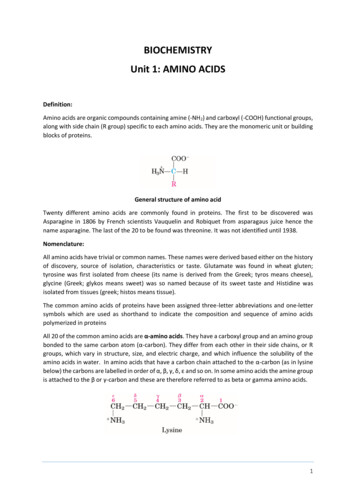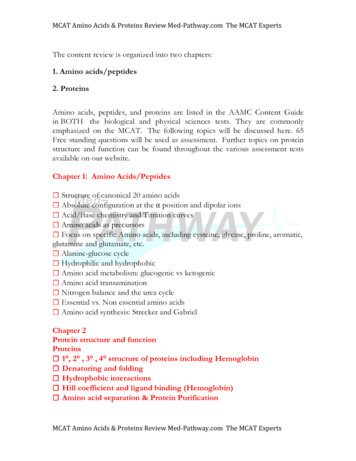
Transcription
MCAT Amino Acids & Proteins Review Med-Pathway.com The MCAT ExpertsThe content review is organized into two chapters:1. Amino acids/peptides2. ProteinsAmino acids, peptides, and proteins are listed in the AAMC Content Guidein BOTH the biological and physical sciences tests. They are commonlyemphasized on the MCAT. The following topics will be discussed here. 65Free standing questions will be used as assessment. Further topics on proteinstructure and function can be found throughout the various assessment testsavailable on our website.Chapter 1: Amino Acids/Peptides Structure of canonical 20 amino acids Absolute configuration at the α position and dipolar ions Acid/Base chemistry and Titration curves Amino acids as precursors Focus on specific Amino acids, including cysteine, glycine, proline, aromatic,glutamine and glutamate, etc. Alanine-glucose cycle Hydrophilic and hydrophobic Amino acid metabolism: glucogenic vs ketogenic Amino acid transamination Nitrogen balance and the urea cycle Essential vs. Non essential amino acids Amino acid synthesis: Strecker and GabrielChapter 2Protein structure and functionProteins 1 , 2 , 3 , 4 structure of proteins including Hemoglobin Denaturing and folding Hydrophobic interactions Hill coefficient and ligand binding (Hemoglobin) Amino acid separation & Protein PurificationMCAT Amino Acids & Proteins Review Med-Pathway.com The MCAT Experts
MCAT Amino Acids & Proteins Review Med-Pathway.com The MCAT ExpertsIntroductionStructure and function: The key paradigm.Enzymes and other proteins fold into their respective three dimensional shapesthat dictate consequent cellular function(s). Numerous pharmaceutical reagentsexploit structure/function relationships. In particular, development of specificdrugs that bond as agonists (i.e. activators) and antagonists (i.e. inhibitors) hasbeen used in clinical medicine for decades.The vast majority of pharmaceutical drugs target cellular proteins, ranging fromenzyme inhibition to targeting receptors as agonists and antagonists. Asproteins are composed of linear chains of amino acids that fold into afunctional three dimensional conformation, understanding amino acidstructure, particularly in the context of protein function, is a central objective inbiochemistry and we know the MCAT loves this topic. Further, amino acidsand their derivatives play important roles outside of protein structure andfunction in diverse processes. This is because many amino acids are turned intoimportant biomolecules ranging from serotonin (neurotransmission) tohistamine (allergic response, vasodilation). It is therefore clear to see whyamino acid/protein structure and function formulates a very widely coveredMCAT Amino Acids & Proteins Review Med-Pathway.com The MCAT Experts
MCAT Amino Acids & Proteins Review Med-Pathway.com The MCAT Expertstopic area on the MCAT.The primary amino acid sequence of proteins is determined via the mRNAsequence and assembled during ribosomal translation. This is a major theme ofContent Category 1B. The chemical diversity of amino acids and theirnumerous sequence combinations allows for the generation of tertiary foldingstructures that adopt a plethora of conformations and active sites specifyingany number of functions. The canonical 20 amino acids are presented below.Absolute configuration at the α carbonEach of twenty canonical amino acids, with the exception of glycine, is chiral.The structures are shown. Chirality, or handedness, is an important aspect ofbiology and chemistry. It is the subject of the “Principles of Stereochemistry”learning/testing module. Stereochemistry is presented in the Chemical andPhysical Foundations of Biological Systems in Section 5B of the AAMC MCAToutline.With the exception of glycine, each of the amino acids incorporated intoproteins displays optical activity. This is based upon the presence of anasymmetric carbon center (α carbon). For amino acids, there are two possiblestereogenic states: L and D that are related to each other as nonsuperimposable mirror images. Only the L-isomer is incorporated into proteinsin humans, but bacteria use D amino acids in their peptidoglycan walls.MCAT Amino Acids & Proteins Review Med-Pathway.com The MCAT Experts
MCAT Amino Acids & Proteins Review Med-Pathway.com The MCAT ExpertsAmino acids are often represented as Fischer projections as shown. In aFischer projection, the D isomer has the amino function on the right and its Lenantiomer has the amino group on the left. This is shown with serine.Amino acids as dipolar ionsBy definition each amino acid minimally contains a single carboxyl and a singleprimary amine group. The structures of the common twenty amino acids areshown and are grouped into those possessing similar chemical features. Notethat proline is a secondary amine and it therefore technically not an amino acid,but rather an “imino” acid.Do you have to memorize the structures of the amino acids? Perhaps, but atthe minimum you should be able to recognize a given amino acid andimmediately associate its structure with function, particularly with respect to itsgeneral classification as acidic/basic, hydrophobic/hydrophilic, sulfurcontaining, posttranslational modifications etc. That is, you must understandthe chemistry of the amino acid side chains.Acid/Base chemistryAmino acids are diprotic Bronsted-Lowry acids because they dissociateprotons. After dissociation, the protonated species is in equilibrium with itsconjugate base. You should readily be able to distinguish Bronsted-Lowry acidsfrom Lewis acids. In contrast to Bronsted-Lowry acids, the dissociation ofprotons is not important. Rather, Lewis acids accept electron pairs from donorcompounds.MCAT Amino Acids & Proteins Review Med-Pathway.com The MCAT Experts
MCAT Amino Acids & Proteins Review Med-Pathway.com The MCAT ExpertsBronsted-Lowry acids dissociate protons as shown in the equilibriumdissociation with a generic acid designated as HA. The amino and carboxylprotons are considered weak acids because the protons do not completelydissociate under equilibrium conditions. This is in contrast to strong acids thatcompletely dissociate protons. Strong acids include HNO3 (Nitric acid),H2SO4 (Sulfuric acid), HCl (Hydrochloric acid), and HClO4 (Perchloric acid).The extent of proton (H ) ionization can be measured by determining theequilibrium constant Ka, which is defined in this case as the ratio of [A][H ]/[HA]. The equilibrium constant of a reaction depends on various factorsincluding the ionic strength of the buffer and the temperature. High Ka valuessignify the formation of more product(s) than reactant(s) at equilibrium. AsKa values can be very large or small, a more convenient and useful method ofdescribing equilibrium is the “pKa”. By definition:pKa –log[Ka]The pKa of a typical carboxyl group is approximately 2.4 and that of a primaryamino group is about 9.5. You might see other values such as the wholenumbers 3.0 and 9.0. However, keep in mind that the true pKa value isgoverned by the local environment and can change as a function ofenvironment.The pKa value quantifies the strength of a Bronsted-Lowry acid in solution andis therefore related to the acid dissociation constant: pKa -[log]Ka. Youshould be very familiar with the term pKa and how it applies to the HendersonHasselbach equation:pH pKa log[A-]/[HA] orpH pKa log[BASE]/[ACID]MCAT Amino Acids & Proteins Review Med-Pathway.com The MCAT Experts
MCAT Amino Acids & Proteins Review Med-Pathway.com The MCAT ExpertsThis equation is an algebraic manipulation of the generic acid dissociationrelationship: HA H A-. Always appreciate that large pKa values indicatethat a higher pH is required to titrate (dissociate in this case) the proton. Thatis, a high pKa value represents a weak acid.Using the Henderson Hasselbach equationThe pKa value of the imidazole side chain of histidine is 6.4. This means thatat physiological pH 7.4, only 10 % (1/10) of the molecules in solution willexist in the charged, protonated form. This calculation is shown below in theimage. You should be quite familiar with these acid-base calculations and MedPathway has multiple examples and applications of this in this section as well asthe Passage Workbook.Because you appreciate that amino acids are zwitterions at physiological pH,the overall charge will change as a function of pH. This is commonly observedwith titration curves. For some amino acids, the side chains possess ionizablegroups that contribute to the overall charge of the amino acid at a given pH.MCAT Amino Acids & Proteins Review Med-Pathway.com The MCAT Experts
MCAT Amino Acids & Proteins Review Med-Pathway.com The MCAT ExpertsWe just saw this for histidine. In the context of protein primary structure (i.e.the sequence of amino acids as determined through the genetic code), only theside chain will be charged. The only exceptions are the N and C terminal aminoacids.Side chain charges are important for protein structure and function. Theionization states of amino acid side chains often make the difference between afunctional enzyme and a catalytically inactive one. This important point will beseen over and over.Once again, the ionization status of the carboxyl and amino groups depends ontheir respective pKa values and remember that:pKa -log [Ka]The pKa is dependent on several factors including the pH, micro-environment,ionic strength, temperature, and the dielectric constant.Titration of AlanineAs a free amino acid, alanine exists in three ionization states (A, B, and C), eachwith a distinct charge. At low pH, both the carboxyl and amino groups ofalanine are both protonated (Form A, 1 net charge). As more hydroxide ion isadded to the alanine solution, the pH rises until it reaches a value equal topKa1. At this point, ½ of the carboxyl groups will be protonated and the otherhalf will be ionized. This is the ½ equivalence point and can be calculated fromthe Henderson Hasselbach equation. That is, when the pH pKa, theconcentration of COOH the concentration of the conjugate base [COO-],or think of it this way: the concentration of protonated acid (HA) is equivalentto the concentration of conjugated base [COO-]. Keep this in mind:if pH pKa, then [HA] [A-]As the pH is raised through the addition of more equivalents of HO-, thecarboxyl group becomes completely titrated to COO-, the conjugate base. Thisis form B. This pH represents the isoelectric point (pI), the point at which thenet charge on the molecule is zero. Through the addition of more hydroxide,the pH will become equal to pKa2. This is the pH at which ½ of the aminoprotons are titrated (i.e. form C).MCAT Amino Acids & Proteins Review Med-Pathway.com The MCAT Experts
MCAT Amino Acids & Proteins Review Med-Pathway.com The MCAT ExpertsThe following graph shows how the overall charge of an amino acid changes asa function of the pH and the pI of the amino acid. In this case, the diproticamino acid glycine is used as an example. Note that when the pI pH, theoverall charge is positive, but when the pH pI, the overall charge is negative.Amino acid classesAcidic/Basic. Aspartic acid and glutamic acid possess carboxylic acid sidechains with similar pKa values usually designated as being anywhere between2.0-3.0. The amino acid structure shows the carboxylate side chains as theionized conjugate bases, the expected chemical state at physiological pH.Lysine (ε-amino side chain) and arginine (guanadinium side chain) have basicside chains with pKa values of approximately 11.0 and 13.0, respectively. Thepositively charged forms are shown in the table at the beginning of this section,as these are the states expected at the physiological pH of 7.4.The pKa of the side chain of histidine (imidazole) is commonly listed between6.4 and 6.8. This pKa value is the closest of all amino acids to physiological pH(7.4). Thus, at physiological pH a substantial fraction of the histidine sideMCAT Amino Acids & Proteins Review Med-Pathway.com The MCAT Experts
MCAT Amino Acids & Proteins Review Med-Pathway.com The MCAT Expertschains are deprotonated and uncharged. We will see the important role thathistidine plays in enzyme catalysis with the classic example of chymotrypsin.In many cases, lysine methylation plays important roles in various biologicalproperties, especially with respect to gene expression. Lysine can exist in fourdistinct states. This includes the familiar unmodified form as well as the mono-,di-, and tri-methylated forms. Each distinct methylation state can bind tovarious proteins. In the case of chromatin, enzymes that deposit methyl groupson various lysine moieties have been identified and shown to either facilitate orrepress gene expression.Roles of Arginine in Nitrogen regulation.Arginine plays important roles in regulating nitrogen metabolism by multiplemanners that have significant clinical impact and should be studied for theMCAT and beyond.1. Precursor to Urea in the Urea Cycle2. Required for the synthesis of nitric oxide3. Required for synthesis of creatine and creatinineThe urea cycle will be discussed below.Nitric oxide synthesis. Arginine is converted into L-citrulline and nitric oxide, aparamagnetic compound with an unpaired electron through the action of nitricoxide synthase (NOS). NO diffuses through cell membranes where it activatesMCAT Amino Acids & Proteins Review Med-Pathway.com The MCAT Experts
MCAT Amino Acids & Proteins Review Med-Pathway.com The MCAT Expertssoluble guanylyl cyclase (GC). This enzyme converts GTP into cGMP, asignaling molecule that is involved in multiple cellular responses includingvasodilation.Arginine and Creatinine.Glycine and arginine combine in the kidney to form guanidine acetate. Thiscompound is shipped to the liver and methylated by SAM to form creatine.Creatine circulates to the brain, heart, and skeletal muscle. The fate of creatineis shown below:Creatine-phosphate (P) is used an energy source because it phosphorylatesADP to generate ATP. Creatine-P is spontaneously converted into creatinine inMCAT Amino Acids & Proteins Review Med-Pathway.com The MCAT Experts
MCAT Amino Acids & Proteins Review Med-Pathway.com The MCAT Expertsthe muscle and brain. Creatinine production occurs at a fairly uniform rate as afunction of muscle mass; this feature is often exploited by clinicians to assessrenal function. As very little creatinine is reabsorbed in the proximal tubule, anaccurate assessment of the glomerular filtration rate can be derived from thecreatinine clearance rate.Acid/base side chain chemistry in catalysis.The ability of various amino acids to act as either acids or bases makes themkey players at the active sites of enzymes. This is commonly seen on theMCAT. Despite the fact that there are numerous enzymes for the MCAT totest you on, the themes are always very similar. Classic examples includelysozyme and chymotrypsin. One such scenario of base catalysis is seen in theprotease chymotrypsin, a pancreatic enzyme secreted into the duodenumduring digestion.As shown above, chymotrypsin exemplifies a “catalytic triad” where the aminoacids serine, histidine, and aspartate collaborate in promoting hydrolysis of apeptide bond. In this example, we focus on the role of base catalysis. Note thathistidine-57, which is held in place through a hydrogen bond between animidazole nitrogen and aspartate, acts as a base because the second imidazolenitrogen accepts a proton from an active site serine. The OH group isconverted into a stronger, negatively charged nucleophilic oxygen anionicspecies that attacks the electrophilic carbonyl carbon of the peptide bond. Thisis the first step in hydrolyzing the bond. Recall that the stronger the base, thestronger the nucleophile. As O- is a stronger base than OH, deprotonation ofMCAT Amino Acids & Proteins Review Med-Pathway.com The MCAT Experts
MCAT Amino Acids & Proteins Review Med-Pathway.com The MCAT Expertsthe serine side chain promotes catalysis through the generation of a strongerbase.In the second scenario of acid/base catalysis, a hypothetical scheme forhydrolysis of a peptide bond is shown with two key active site residues: lysine(Lys) and serine (Ser). In this scenario, an uncharged lysine side chain acts as abase by accepting a proton from water, generating the stronger, negativelycharged hydroxyl nucleophile.As shown, the HO- nucleophile attacks the electrophilic carbon in the carbonylgroup of the peptide bond, forming a tetrahedral intermediate. Note that theserine residue forms a hydrogen bond with the carbonyl oxygen that helps keepthe peptide bond situated in the active site of the enzyme. During the collapseof the tetrahedral intermediate, the newly protonated lysine residue behaves asa Bronsted-Lowry acid through donating its proton to the nitrogen atom in thepeptide bond. This generates a stronger leaving group (NH2 vs NH-). Recallthat the best leaving group is the weakest base. (Weak bases do not shareelectrons very well, making the bond easier to break.) Without receiving theproton from lysine, the leaving group would be R1NH-, but with the additionof the proton, the leaving group becomes R1NH2, a neutral species and weakerbase than R1 NH-.MCAT Amino Acids & Proteins Review Med-Pathway.com The MCAT Experts
MCAT Amino Acids & Proteins Review Med-Pathway.com The MCAT ExpertsSulfur containing. Methionine contains a sulfide group (–CH2CH2-S-CH3)and is notorious for starting polypeptide chains through its AUG initiationcodon during ribosomal translation in both prokaryotes and eukaryotes.Methionine is a non-essential amino acid because it is synthesized in the bodythrough a reaction that uses Vitamin B12 as a methyl donor (CH3-B12). Thepathway is shown below. Addition of a methyl group to homocysteine createsmethionine. Afterwards, appreciate that methionine can be used in two majorways:1) as an amino acid component of proteins.2) conversion into the methyl donor, S-adenosyl methionine (SAM).SAM is used to add methyl groups (one carbon) to numerous substratesincluding nucleic acids and proteins.CysteineCysteine contains a sulfhydryl side chain (-SH) as part of its side group and thishas important ramifications for multiple aspects of its biology and chemistry.Reactive cysteine residues in active sites of enzymes often have pKa values thatare considered low for generic sulfhydryl groups. Indeed, once ionized, thenegatively charged anion serves as a more potent nucleophile relative to itsprotonated form. This is shown below through the modification of cysteinewith farnesylpyrophosphate, an isoprenoid molecule derived from thecholesterol biosynthetic pathway. Isoprene molecules are also called terpenesand are listed in the AAMC Content Outline in Foundation 3A.MCAT Amino Acids & Proteins Review Med-Pathway.com The MCAT Experts
MCAT Amino Acids & Proteins Review Med-Pathway.com The MCAT ExpertsThe addition of isoprenoid molecules to cysteine residues is often called“prenylation”, a reference to the addition of isoprenoid groups. Think ofprenylation as the addition of a large alky chain to a substrate. As such, theaddition of these hydrophobic groups often serves to anchor the protein intothe cell membrane. The enzyme mechanism of prenylation is further examinedin the Med-Pathway Passage Workbook.Disulfide LinkageCysteine most notoriously participates in disulfide bonds that are majorcontributors to protein structure and function. Disulfide bonds are formedthrough the oxidation of two cysteine residues, forming a cystine linkage (R-SS-R) as shown above in the figure. These disulfide linkages are introduced intovarious proteins (i.e. insulin) in the endoplasmic reticulum and are commonlyfound in secreted proteins. Either intrachain or interchain cysteine side chainsmay form covalent linkages as is the case for insulin. Further, all cysteineresidues are NOT obligated to participate in disulfide bonding.Aromatic amino acids. Phenylalanine (Phe) is converted into tyrosine (Tyr)in an important reaction that forms the basis for the disease phenylketonuria.Both amino acids are also precursors for important molecules such as L-DOPAand epinephrine.MCAT Amino Acids & Proteins Review Med-Pathway.com The MCAT Experts
MCAT Amino Acids & Proteins Review Med-Pathway.com The MCAT ExpertsBoth phenylalanine (Phe) and tyrosine (Tyr) contain benzene rings as part oftheir side chains. The difference between the two residues is the presence ofthe hydroxyl group in tyrosine. Right off the bat, interpret this to mean that theside chain of tyrosine can participate in hydrogen bonding, but the side chainof Phe cannot. Tyrosine has a large side chain, and despite the presence of thealcohol group, it is a relatively hydrophobic.L-phenylalanine hydroxylase (PAH) converts Phe into Tyr. PAH is amonooxygenase enzyme that uses tetrahydrobiopterin (BH4) as a redox cofactor to add the hydroxyl to Phe, generating tyrosine. This is seen in the greenstep in the figure. Tyrosine hydroxylase conducts the rate limiting synthesis of aclass of molecules called catecholamines (i.e. L-DOPA) and also uses BH4 as aco-factor. Other important catecholamines include epinephrine,norepinephrine, and dopamine. Therefore, both Phe and Tyr are precursors toimportant neurotransmitters and hormones.Tryptophan. L-tryptophan is incorporated into proteins and contains theindole side chain. L-tryptophan is a precursor in the synthesis of melatonin, theessential human nutrient niacin (nicotinic acid), and serotonin, an importantneurotransmitter. The synthesis of serontonin is shown below. Hydroxylationof L-tryptophan via tryptophan hydroxylase. Like the enzymes that catalyze thesynthesis of L-tyrosine and L-DOPA, tryptophan hydroxylase is a biopterindependent enzyme.MCAT Amino Acids & Proteins Review Med-Pathway.com The MCAT Experts
MCAT Amino Acids & Proteins Review Med-Pathway.com The MCAT ExpertsGlycine and ProlineGlycine is the smallest amino acid and is achiral by virtue of having twohydrogen atoms bonded to the same α carbon atom. Besides its important rolein protein structure and function, glycine is used in the biosynthesis of bothpurines and heme. Importantly, in the first step of heme biosynthesis, theenzyme aminolevulinic acid (ALA) synthase generates aminolevulinic acid(ALA) from glycine and succinyl CoA. This enzyme is a key regulator of hemebiosynthesis. As the amino group is on the delta position, the product is oftenreferred to as δ-aminolevulinate.Glycine is a nonessential amino acid and is generated from serine as shownbelow. The reaction is reversible. The enzyme serine hydroxymethyltransferseuses a carbon moiety from tetrahydrofolate (TH4), a one-carbon methyldonor. Remember that in the conversion of uracil into thymine, TH4 is alsoused as a critical methyl donor. For the conversion of serine into glycine, serinedonates its carbon to increase the cellular pools of N5, N10 methylene TH4, aform of folic acid poised to donate a methyl group in additional biochemicalreactions. Thus, serine and glycine differ by one carbon.MCAT Amino Acids & Proteins Review Med-Pathway.com The MCAT Experts
MCAT Amino Acids & Proteins Review Med-Pathway.com The MCAT ExpertsProline is technically an imino acid as the nitrogen is a secondary amine. Proylylhydroxylases generate hydroxyproline, a highly enriched posttranslationalmodification in the protein collagen as well as in other important cellularregulators. Collagen is an important structural protein and proline residues playa key role in its function. Collagen is an abundant structural protein found invarious types of connective tissues in animals. This includes tendons, skin,cartilage, and ligaments.MCAT Amino Acids & Proteins Review Med-Pathway.com The MCAT Experts
MCAT Amino Acids & Proteins Review Med-Pathway.com The MCAT ExpertsCollagen adopts a triple helical structure that largely consists of repeating aminoacid motifs composed of either G-P-X or G-X-hydroxyproline. Prolinehydroxylation is added in the lumen of the ER and this modificationcontributes to the high tensile strength characteristic of a structural protein.Aldol cross links between lysine residues generate interstrand cross links thatfurther strengthen the collagen triple helix and collagen fibers. Defects incollagen, particularly through missense mutations in glycine and proline (orhydroxyproline) residues are causal for many diseases including osteogenesisimperfecta, commonly known as brittle bone disease.The unique ring structure of the imino acid proline grants it several interestingproperties important in regulating protein folding, structure, and function.Under normal conditions, the trans rotamer is highly favored over the cis formin the peptide bonds of proteins. This is because there is a significant activationenergy barrier (20 kcal/mol) between converting the trans to the cis form thatarises due to steric hindrance. However, in X-Pro peptide bonds (X anyamino acid), the energy barrier between cis and trans is greatly reduced. Thus,the cis peptide bond is more frequently seen in X-Pro sequences. Despite this,the cis proline bond is not formed spontaneously, but rather is catalyzed byproline isomerase enzymes as shown below.Altering between the cis and trans states has important functional ramificationsfor proteins. Think of proline isomerization as a molecular switch wherecis/trans represent on/off or off/on switches. Roles for proline isomerizationhave been reported in numerous cellular processes including the cell cycle andneurotransmission. For example, one study published in Nature by LummisMCAT Amino Acids & Proteins Review Med-Pathway.com The MCAT Experts
MCAT Amino Acids & Proteins Review Med-Pathway.com The MCAT Expertsand colleagues showed that cis and trans isomerization regulated the functionof a neurotransmitter-dependent ion channel.Polar, non charged amino acids. We have included serine, threonine,asparagine, and glutamine in this category. At various target points withinpolypeptide chains, serine and threonine, two uncharged polar amino acidswith hydroxyl side chains, serve as substrates for kinases that transfer thephosphate from ATP to the targeted side chain in the protein. This generatesan overall negative charge due to the ionization state of phosphate.Phosphorylation of proteins can activate or downregulate the activity ofproteins.MCAT Amino Acids & Proteins Review Med-Pathway.com The MCAT Experts
MCAT Amino Acids & Proteins Review Med-Pathway.com The MCAT ExpertsThe aliphatic alcohols serine and threonine each have pKa values expected forthis functional group ( 13.0). Serine is synthesized from the glycolyticintermediate 3-phosphoglycerate and serves as a substrate for the synthesis ofglycine.Serine and threonine (O-glycosylation) are glycosylated in many membrane andsecreted proteins. Further, asparagine can also be linked through its side chainwhere it forms N-linked sugars such as N-acetylgalactosamine. These sugars areadded posttranslationally in the Golgi apparatus by specific enzymes.Glutamine. Glutamine is a very important amino acid because it is the majornitrogen carrier in the body. Through this, glutamine is intimately related toglutamate. Think of glutamine as carrying two amino groups and glutamate ascarrying one. Because it can be synthesized from glutamate via glutaminesynthetase, glutamine is not an essential amino acid.Three major enzymes in the metabolism of glutamine are shown below. Themajority of glutamine is synthesized in the muscle and liver, but glutaminesynthetase is also active in the intestinal tract, the residential site of themicrobiota. Here, bacterial metabolism often generates free ammonia, aMCAT Amino Acids & Proteins Review Med-Pathway.com The MCAT Experts
MCAT Amino Acids & Proteins Review Med-Pathway.com The MCAT Expertspotentially toxic agent. To rid the system of this, glutamine synthetase couplesfree ammonia to glutamate, generating glutamine. In contrast to this, kidneyglutaminase hydrolyzes glutamine, releasing free ammonia and glutamate. Theresulting ammonia assists in urine buffering.In the liver the amino groups from excess glutamine and glutamate are releasedvia glutamate dehydrogenase and glutaminase. The free ammonia is rapidlycoupled with CO2 and ATP to generate carbamoyl phosphate. This nitrogencarrier enters the urea cycle, a hepatic specific process that converts ammoniainto urea, a nitrogenous waste product. The urea cycle is discussed in moredetail below.Asparagine. Asparagine is synthesized in two steps starting from oxaloacetate(OAA). OAA and aspartate are intraconvertible through a reversibletransamination reaction as shown. Transamination plays a central role inregulating nitrogen balance, a process directed by transaminase enzymes. Thesepyridoxamine-dependent enzymes catalyze the exchange of keto groups forMCAT Amino Acids & Proteins Review Med-Pathway.com The MCAT Experts
MCAT Amino Acids & Proteins Review Med-Pathway.com The MCAT Expertsamino groups. As often seen, nitrogen is donated to alpha-ketoglutarate toform glutamate as a product. Transamination is discussed in more detail below.Next, asparagine synthetase uses aspartate to generate asparagine as shown.Note again the presence of glutamate and glutamine as nitrogen donors.Asparagine synthetase deficiency is a rare autosomal recessive disease and isconsidered a neurometabolite disorder because this is accompanied bymicroencephaly, seizures as well as spasitc quadriplegia. Genes that aredeficient in amino acid metabolism are known as “aminoacidopathies”.Aliphatic amino acids. We listed four amino acids as aliphatic. Three of thefour (leucine, isoleucine, and valine) are commonly referred to as the “branchedchain amino acids” or BCAA based upon the structures of their side chains.Each of the BCAAs is essential and is abundant in muscle as they comprise upto 30% of
The following graph shows how the overall charge of an amino acid changes as a function of the pH and the pI of the amino acid. In this case, the diprotic amino acid glycine is used as an example. Note that when the pI pH, the overall charge is positive, but when the pH pI, the overall charge is negative. Amino acid classes Acidic/Basic.
